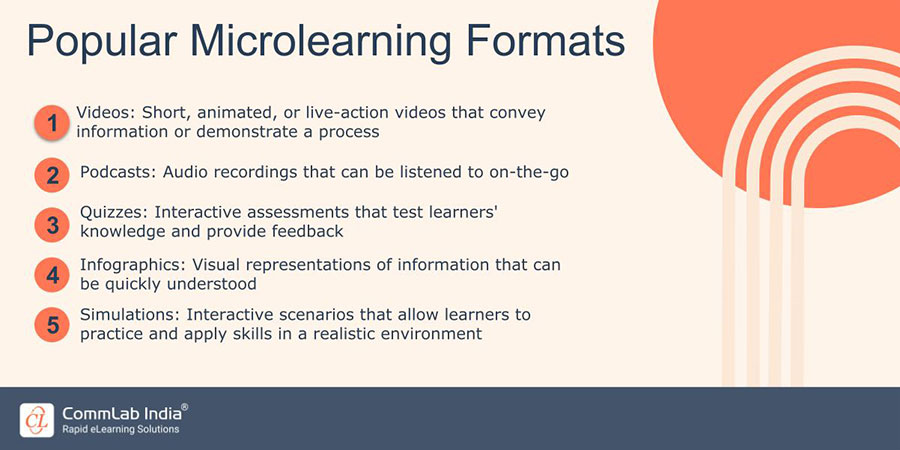Why and How of Microlearning for Impactful Process Training
Overwhelmed by process training? Microlearning offers quick, focused solutions. Learn how microlearning makes process training more engaging and effective.

Process training is essential for employees across all industries. Whether it's onboarding a new employee, teaching new product features, or ensuring compliance with safety regulations, process training helps employees understand and follow the steps required for successful outcomes. However, traditional training methods can often be long, tedious, and ineffective – leading to knowledge gaps and decreased productivity. This is where microlearning comes in. Microlearning offers a powerful solution for process training, allowing organizations to reap significant benefits. Let's delve into why microlearning is ideal for process training and how to use it effectively.
Trying to Design Impactful Process Training? Try Microlearning!
Here’s what it helps with -
- Focus and specificity
- Accessibility
- Just-in-time support
- Improved knowledge retention
- Adaptability
What is Microlearning?
Microlearning is a training approach that breaks down information and processes into bite-sized, focused learning modules. Typically, a microlearning module covers a single learning objective and can be completed in a few minutes. These modules can utilize various formats like:

→ Download Worksheet Now: What Microlearning Is and What It Is Not
Why Microlearning for Process Training?
Microlearning's unique characteristics make it highly suitable for process training:
- Focus and Specificity: Process training often involves learning sequential steps or detailed procedures. Microlearning's focused approach allows learners to master one concept or step at a time without cognitive overload.
- Accessibility: Short learning units are easier to squeeze into busy work schedules, improving training accessibility without major disruptions.
- Just-in-Time Support: Microlearning modules serve as on-demand resources that employees can access precisely when they need them to clarify steps, refresh their memory, or troubleshoot problems while performing a process.
- Improved Knowledge Retention: Microlearning utilizes spaced repetition – revisiting information over spaced intervals. This technique significantly boosts long-term knowledge retention compared to lengthy training sessions.
- Adaptability: Processes change over time, and microlearning's modular nature makes updating content easier and less time-consuming than revising entire training manuals or courses.
- Measurable: You can easily track completion rates and assessment results of individual microlearning modules, helping identify areas where employees might need additional support.
How to Implement Microlearning for Process Training
Here's a step-by-step approach for integrating microlearning into your process training strategy:
1. Identify the Processes to Train
Start by outlining the most critical processes employees need to learn. Consider onboarding processes, standard operating procedures, new software implementations, compliance regulations, and any processes prone to errors.
2. Break Processes into Micro-steps
Deconstruct each process into its smallest, fundamental components or steps. Each step should ideally become the focus of a single microlearning module.
3. Select the Right Formats
Choose suitable formats for each step. Consider the complexity and nature of the step, and align the delivery format to the learning goal:
- Short videos or animations are great for demonstrating physical actions or software procedures.
- Infographics and diagrams effectively represent process flows and decision points.
- Interactive quizzes or scenario-based simulations are excellent for testing understanding and applying knowledge.
4. Develop High-Quality Content
Ensure your microlearning content is:
- Engaging: Use visuals, interactive elements, and relatable examples.
- Relevant: Align the content tightly with the specific learning objective.
- Actionable: Provide clear instructions and practical tips employees can immediately apply.
5. Deploy a Suitable Platform
Consider a Learning Management System (LMS) or authoring tools that support microlearning. Choose a platform that enables easy delivery, tracking, and updating of your microlearning modules. Here are a few authoring tools you can use:

6. Encourage a "Learning in the Flow of Work" Culture
Promote the idea of accessing microlearning resources within the context of their daily work. Integrate micro modules into knowledge bases, internal wikis, and communication platforms.
7. Gather Feedback and Refine
Monitor completion rates, knowledge tests, and survey employees to gather feedback on the effectiveness of your microlearning modules. Continuously refine the content and delivery methods based on the data.
Examples of Microlearning for Process Training
- New Employee Onboarding: Create a series of short videos on tasks new hires need to perform regularly (e.g., entering timesheets, accessing documents, requesting vacation).
- Software Training: Use screencasts or simulations to teach employees how to navigate new software features step-by-step.
- Safety Procedure Compliance: Develop interactive modules with quizzes to ensure employees understand safety protocols before operating machinery.
- Customer Service Process: Design microlearning modules that demonstrate customer interaction scenarios, communication techniques, and conflict resolution tactics.
Key Considerations for Success
- Variety is Key: Leverage a diverse mix of microlearning formats to maintain engagement and appeal to different learning styles.
- Keep it Short and Sweet: Aim for modules no longer than 3-5 minutes to maximize attention.
- Reinforce Learning: Consider gamification, spaced practice quizzes, or short simulations to strengthen knowledge retention and application.
- Provide Context: Briefly explain how each micro-module fits into the overall process to give learners a broader perspective.
Wrapping Up!
Microlearning is a powerful tool that can revolutionize process training, improving knowledge retention, engagement, and on-the-job performance. By breaking complex processes into small, easily digestible chunks and delivering them strategically, you boost the effectiveness of your training and empower employees to excel in their roles. Consider adopting microlearning to create a modern, impactful, and results-driven approach to process training. Here’s a worksheet you can check out if you want to know more about what microlearning is and what it isn’t.





